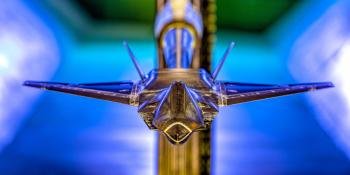A glimpse of the Tempest's "world-first technology"
Rolls-Royce has unveiled the first details of the “world-first technology” that will be incorporated into the Tempest next-generation fighter aircraft.
The company released the details of its Embedded Electrical Starter Generator (or E2SG) demonstrator project on January 10 – which has been in development since 2014, before the launch of the UK-led Tempest programme.
According to Rolls-Royce, the E2SG has been embedded in the core of a gas turbine engine. With this system, the company aims to provide “unprecedented levels of electrical power demand and thermal load” to the next-generation fighter, whilst providing it with more electric, intelligence and power.
![Tempest [BAe Systems]](https://fullfatthings-keyaero.b-cdn.net/sites/keyaero/files/styles/article_body/public/inline-images/Tempest%20%5BBAe%20Systems%5D%20%231_0.jpg?itok=zx-UQWgY)
Conrad Banks, chief engineer for Future Programmes at Rolls-Royce, said: “The electrical embedded starter-generator will save space and provide the large amount of electrical power required by future fighters.”
“Existing aircraft engines generate power through a gearbox underneath the engine, which drives a generator. In addition to adding moving parts and complexity, the space required outside the engine for the gearbox and generator makes the airframe larger, which is undesirable in a stealthy platform," he added.
Phase one of the programme saw significant investment made into the development of an integrated electrical facility – a test centre where gas turbine engines can be connected to a DC electrical network.
Rolls-Royce launched the second phase of the E2SG project in 2017, and this has now been taken in under the company’s contribution to the Tempest programme. During phase two, Rolls-Royce connected a second electrical generator to the engine’s other spool. It also saw the inclusion of an energy storage system in the electrical network, along with the ability to intelligently manage the supply of power between all these aircraft systems.
According to Rolls-Royce, “the two-spool mounted electrical machines allow, by combination of operation as either a motor or a generator, the production of a series of functional effects on the engine, including the transfer of power electrically between the two spools.”
![Rolls-Royce Engine Tech - Tempest [Rolls-Royce]](https://fullfatthings-keyaero.b-cdn.net/sites/keyaero/files/styles/article_body/public/inline-images/Rolls-Royce%20Tempest%20Engine%20Tech%20%5BTeam%20Tempest%5D%20%231.jpg?itok=_KST4PjC)
The company is currently investigating the practicality of dual spool generation to determine the efficiency, operability and responsiveness of the engine. Rolls-Royce has also employed its Power Manager intelligent control system – which is also in development. The company states that the platform “uses algorithms to make real time intelligent decisions about how to supply the current aircraft electrical demand while optimising other factors including engine efficiency to reduce fuel burn or engine temperature to extend component life.”
Rolls-Royce will continue to mature electrical technologies seen in the E2SG programme throughout the Tempest project, with a third phase planned to test a novel thermal management system and more electric engine accessories integrated into the system. A full-scale Advanced Power and Propulsion System (APPS) demonstrator is also planned to be showcased.
For more military aviation technology news visit our military aircraft technology news section.

![FCAS [Dassault Aviation] European FCAS](https://fullfatthings-keyaero.b-cdn.net/sites/keyaero/files/styles/listing_card/public/2020-02/da00037244_s.jpg?h=e891456c&itok=5rzlYNgE)




